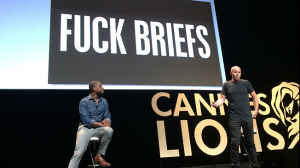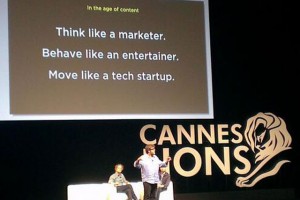Among the many talks that I was lucky to attend at this year’s Cannes Festival of Creativity, I was particularly inspired by the “Building a billion dollar brand” seminar given by Omar Johnson from Beats and James Temple from R/GA – here is a short clip of that seminar (starting at minute 3:40):
When Bob Greenberg introduced Omar and James, the first thing he did was to correct the title of the presentation. Instead of 1 billion Apple paid 3 billions for Beats Music and Beats Electronics! Quiet an impressive sum for a company that was founded in 2006 and started selling its first earphones in 2008.
What impressed me though, weren’t the big numbers, but how quickly Beats turned into an iconic brand and how it got there. Omar and James talked about 5 pillars that helped turn Beats into such a successful brand.
TRUTH – CULTURE – CREATIVE – HUSTLE – FAMILY
A lot has been written and said about most of these pillars, but when it comes to CULTURE, Beats is a real benchmark to me and one sentence that Omar said still resonates to my ears: “the key challenge is to be able to create content at the speed of culture”. One example he gave for that was the spot for Beats pills on Miley Cyrus that was aired immediately after the very much talked about performance of Miley at the MTV awards:
Beats is off course very fortunate to have access to many cultural icons in the area of sports or music. But what is impressive to me is the way Beats and R/GA work together to use those assets to produce content which is truly able to move at the speed of culture. Let me just pick up on three dimensions of that working relationship, which I believe represent the way forward for how agencies and clients need to profoundly change the way they work together to deliver content at the speed of culture.
The first element is the need (or not) for BRIEFS. There were a lot of debates about one chart that James pulled up with “Fuck briefs” written on it (photo courtesy of Engin Gedik):
The biggest criticism was that Omar’s and James’ description of the Brief as “a longstanding archaic and pointlessly bureaucratic process” – to quote David Garner from Adweek – doesn’t reflect the way many agencies use briefings nowadays. I agree to that criticism since the days where planners picked up a brief and disappeared for several days before presenting it to creatives and then changing it several times (while rarely involving the client) until it finally got approved are long gone. To quote Daz McColl, Chief Brand Strategy Officer at SapientNitro “I just thought they missed the point. If that’s an issue for them, then they don’t get it, because it should never be about the brief. It’s about the conversation“.
At Grey we have that conversation very early on and invite the client to join to make sure we’re fully aligned about the business issue at hand and the strategic direction we need to take the brand. This is part of our OPEN culture. In my view another point of criticism to “No briefs” is the fact that well-articulated and precise strategies become even more important when you are trying to react fast and real time.
The second dimension is SPEED. Moving at the speed of culture will require agencies and clients alike to become a lot more agile. Omar gave an example of what he meant by SPEED when they aired the following commercial with Colin Kaepernick on the day where the San Francisco 49ers where playing against the Seattle Seahawks:
When Beats heard that the Seattle fans were going to boycott their products in reaction to the way they were portrayed in the commercial, Omar contacted R/GA telling them they had signed Richard Sherman from the Seattle Seahawks and that the agency had one week to come up with an idea and shoot the commercial. The result was another buzzed about spot:
The ephemeral nature of cultural trends will force agencies and clients alike to rethink not just the way they create, test and distribute content, but also who needs to get involved to produce that content. PJ Pereira summarized that really well on another “talked about” chart.
The last dimension I want to comment on is the 5th pillar Omar mentioned during his speech: FAMILY. Listening to Omar and James made me realize the true spirit of collaboration that unites Beats to R/GA. In times where agency pitches (most of them without remuneration) are frequently being used to keep agencies “on their toes” or simply to reduce fees, it was very motivating to see and sense the connection and sense of partnership between Beats and R/GA. It’s easy to believe Omar when he talks about FAMILY to describe the relationship that Beats has to all its partners and not just R/GA and when he goes on saying that teams literally eat, drink and sleep together while working on projects. By defining FAMILY as one of the central pillars on which the success of Beats is based, Omar Johnson takes a quiet different view to Sir John Hegarty’s warning (during his Cannes talk with David Droga) about creatives getting too close to Clients: “A degree of distance is important, you need to have an ability to observe from afar. Otherwise you end up having the same perspective as your client, and that’s the last thing you want.” Well, as always I guess you have to put things into perspective. As a father of two kids I would say that a sense of FAMILY doesn’t necessarily mean having the same perspective, certainly not when you have a 10 year old daughter.

